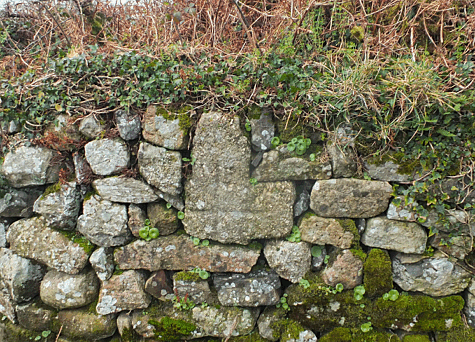
As you trundle up the steep, narrow lane that comes from Harbourneford with its high banks you suddenly come across the cattle gridded entrance to Gisperdown Farm. To the right of the cattle grid is an extremely neat ivy-capped field wall. After a casual glimpse you realise that embedded in the wall is a cross head with a missing arm. There are several other cross-heads embedded in walls and a bridge parapet dotted around Dartmoor such as at Budleigh Bridge, in the wall of Stannon Lodge, the cottage at Swallerton Gate and the wall of Buckland Manor. As to why nobody exactly knows. I have a couple of suggestions, firstly during Puritan times many of the idolatrous crosses were ordered to be knocked down. Not everyone was happy in despoiling such Christian symbols and so the cross heads were hidden away until such a time as they could be reused. What better place to preserve one than in a stone wall? Secondly, human nature being what it is and the penchant for the easy route the stone crosses, once the heads had been knocked, off provided ready made gate posts that needed no fashioning. The redundant cross heads were often discarded in various places and later relocated for whatever reason. So when discovered it may well be that there was some misguided belief that embedding such in ones property would provide divine protection?

There is no early reference to the providence of Gisperdown cross, neither William Crossing in his book ‘The Ancient Stone Crosses of Dartmoor, nor Starkey in his ‘Dartmoor Crosses’ work. It is not until 2001 that the first description of the cross appears in Bill Harrison’s ‘Dartmoor Stone Crosses’ publication. Sometime around 1947 some men were repairing a wall and bank at Gisperdown when they came across the old cross head. Their find consisted of part of the shaft with one arm attached and the other arm detached. So the men carried on with their work in the hope that they would come across the shaft, sadly this was not to be. For some odd reason they decided to salvage the main part of the head but to reuse the broken arm in the back fill of the wall. Eventually the farmer came to inspect the finished wall and was told of the discovery. Apparently farmer Codd had a deep interest in Dartmoor’s heritage and over the years had collected various finds that he had come across. Presumably he thought the cross would be an interesting addition to his collection. Despite the fact that the wall had been finished he instructed the men to pull it apart again and search for the missing arm – all to no avail. At the time of writing his book Harrison noted that the cross head was lying; “on the grass near the gate and within the farmyard.” Fortunately Harrison took a description of the cross head whilst it was still in the farmyard. He noted that it’s height was 48.1 cm, with a span of 42 cm, on both faces there was an incised cross.
As can be seen above since then it has found a new home by being embedded to the field wall. Thanks to Harrison’s description we know that there is an incised cross on both sides otherwise today it would be impossible to know. With regards to the missing shaft it appears that some tin miners at ‘Wider Brook Clitters’ had used in in the construction of a shelter. In Mike Brown’s ‘Gazetteer of Dartmoor Names’ he places these clitters some 600 metres east of Western Whittabarrow. Harrison also says how the farmer has a theory that this cross may have been the fourth cross which marked the boundary of Brent Moor. Today Hobajon’s, Petre’s and Huntingdon crosses are still in-situ but the fourth which would have been at Buckland Ford has been lost in the mists of time. Buckland Ford is only about 500 metres south from where ‘Wider Brook Clitters’ is located. So it just may be possible that this cross head belonged to the missing cross which was utilised in the construction of the tinner’s shelter? However, working on the assumption that the cross head was still associated with the shaft it had somehow been transported around 4.5 kilometres to Gisperdown? As to the missing shaft, maybe it’s still knocking around somewhere in Wider Brook Clitters’? – Harrison, pp. 123 -124.
Whatever the story behind the cross thanks must go to Farmer Codd for preserving a part of Dartmoor’s heritage in such a manner as for all to see.

Harrison, B. 2001. Dartmoor Stone Crosses. Tiverton: Halsgrove Publishing.
Brown, M. 1995. The Gazetteer of Dartmoor Names. Liverton: Forest Pub.
 Legendary Dartmoor The many aspects past and present of Dartmoor
Legendary Dartmoor The many aspects past and present of Dartmoor
